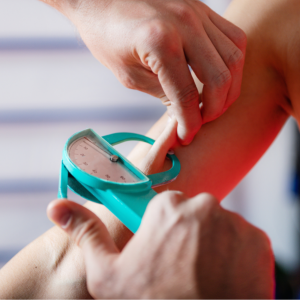The focus of this lesson is to help prepare you to calculate the amount of weight you want to lose based on the body fat percentages you want to fall within.
In this lesson, you will cover
-
- what does body composition mean
- why assessing your body fat percentage is essential; and
- how to calculate your body fat percentage.
Once you calculate your body fat percentage, I will ask you to figure out
-
- which body fat category do you fall within now; and
- what body fat percentages would you like to fall within as your ultimate goal?
To complete this lesson, you will
-
- want to use the body fat calipers and/or use the body composition scale I mentioned in the Tools you need to be successful lesson in the introduction; and
- go to a nutrition shop with a machine that will calculate your body composition scale (or use a body composition scale).
Body composition definition
Body composition refers to the relative amounts of fat, muscle, and bone in the body. It’s an important measure of overall health and fitness, as having too much body fat or too little muscle mass can increase the risk of a variety of health issues, including diabetes, heart disease, and osteoporosis.
Factors that influence body composition
Several factors can influence body composition, including genetics, age, sex, diet, exercise, and overall lifestyle. For example, individuals with a genetic predisposition to store more fat may have a higher body fat percentage. In contrast, those who engage in regular strength training may have a higher muscle mass.
Why is it important to understand your body fat percentage?
There are many reasons to understand your body fat percentage.
First, knowing your body fat percentage allows you to understand which body fat category you fall within. There are five body fat categories:
- athletic group
- optimum health/fitness
- warning zone
- clinical obesity
- morbid obesity
Second, it also helps you understand any health risks you may be at or could be facing. For example, your waist circumference can be used as another health risk indicator. Guys with a waist circumference over 40 inches are at numerous health risks. Women with a waist circumference over 35 inches are too.
Click the link below to learn more about how a person’s waist circumference puts them at health risk. In addition, there are top-tier blogs by leading word health organizations and ivy league schools’ research studies on this subject in the link below.
https://www.google.com/search?q=what+health+risk+are+people+at+with+a+large+waist+circumference
Methods for measuring body composition
There are several methods for measuring body composition, including:
-
Body Mass Index (BMI): BMI measures body fat based on height and weight. It’s calculated by dividing weight in kilograms by height in meters squared. While BMI is a useful screening tool, it has limitations and may not accurately measure body composition for athletes or those with a high amount of muscle mass.
-
Skinfold Calipers: Skincare calipers are used to measure the thickness of skinfolds at different locations on the body. These measurements are used to estimate body fat percentage.
-
Bioelectrical Impedance: Bioelectrical impedance uses a small electrical current to measure the resistance of body tissues. This information is used to estimate body fat percentage. Bioelectrical impedance scales or devices can be found in many health and fitness centers, medical facilities and can also be purchased for home use online or in some retail stores, such as the body composition scale I mentioned earlier.
-
Dual-energy X-ray Absorptiometry (DXA): DXA is a medical imaging technique that uses X-rays to measure bone mineral density and body composition. It’s considered one of the most accurate methods for measuring body composition. DXA machines are usually found in medical facilities such as hospitals, clinics, and specialized imaging centers. They are operated by trained professionals and are not typically available for home use.
By understanding your body composition, you can develop a more effective fitness plan that takes into account your unique characteristics and goals. It’s important to work with a qualified healthcare professional to determine the best method for measuring your body composition and to interpret the results.
Body Mass Index Calculator
You calculated your body mass index in the last lesson. However, I wanted to provide you the Body Mass Index Calculator in this lesson as well just in case you skipped it 🙂 or didn’t want to switch lessons to find it.
How to use calipers to measure skinfold thickness

Screenshot of how to use calipers to measure skinfold thickness (Hatfield, 2018, p. 366)
If you choose to use the caliper method, take
- your measurement directly on the skin;
- all of the measurements on one side of the body; and
- each measurement three times and average the closet two.
Follow the directions below to measure your skinfolds in each section. Take and record each sections’ measurement in millimeters. Once you are done, go to the Body Fat Calculator below. Click the BMI tab first. Second, click the 7-site skinfold calculator to use the Jackson & Pollock 7-site skinfold formula to calculate your body fat percentage, body fat category, body mass index, body fat weight, and lean body mass.

Screenshot of Figure 11.2a Skinfoldsites and descriptions: triceps, subscapular, pectoral, and mid-axillary (Hatfield, 2018, p. 366)

Screenshot of Figure 11.2b Skinfold sites and descriptions: abdominal, suprailiac, quadriceps, and calf (Hatfield, 2018, p. 367)
The last thing I’d like you to do is write down what body fat category you’d like to see yourself in eventually and the body fat percentage ranges within that category. You can see the percentages of the body fat ranges in the calculator above. Choose which you ultimately would like to see yourself in. To reach that ideal body fat percentage range, you will use this information to calculate your goal from your current weight.
Side notes:
- I will ask you your body fat percentage in the Body Assessment. Please write down your current body fat percentage for easy reference.
- I will ask you which body fat percentage range you would ultimately like to see yourself in our goal-setting session. Please keep these goals for easy reference as well.
If you choose to use the caliper method, take
- your measurement directly on the skin;
- all of the measurements on one side of the body; and
- each measurement three times and average the closet two.
Follow the directions below to measure your skinfolds in each section. Take and record each sections’ measurement in millimeters. Once you are done, go to the Body Fat Calculator below. Click the BMI tab first. Second, click the 7-site skinfold calculator to use the Jackson & Pollock 7-site skinfold formula to calculate your body fat percentage, body fat category, body mass index, body fat weight, and lean body mass.
Sources
Hatfield, F. C. (2018). Screenshot of how to use calipers to measure skinfold thickness in the Fitness: The complete guide (9th ed.) [image file]. Retrieved from https://www.issatrainer.com/certification-courses/textbooks/453/fitness-the-complete-guide-ninth-edition/366
Hatfield, F. C. (2018). Screenshot of Figure 11.2a Skinfoldsites and descriptions: triceps, subscapular, pectoral, and mid-axillary in the Fitness: The complete guide (9th ed.) [image file]. Retrieved from https://www.issatrainer.com/certification-courses/textbooks/453/fitness-the-complete-guide-ninth-edition/366
Hatfield, F. C. (2018). Screenshot of Figure 11.2b Skinfold sites and descriptions: abdominal, suprailiac, quadriceps, and calf the Fitness: The complete guide (9th ed.) [image file]. Retrieved from https://www.issatrainer.com/certification-courses/textbooks/453/fitness-the-complete-guide-ninth-edition/367


